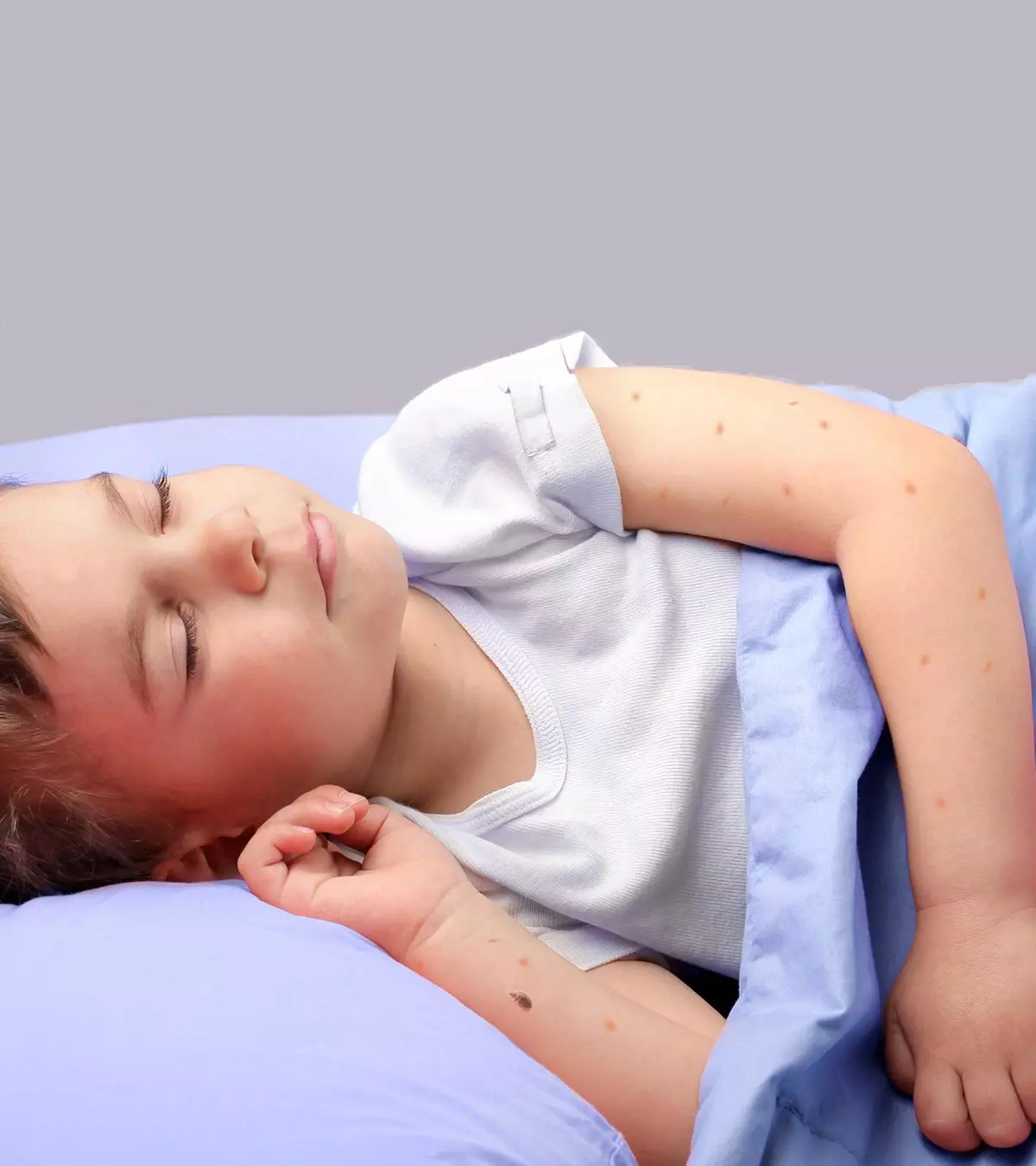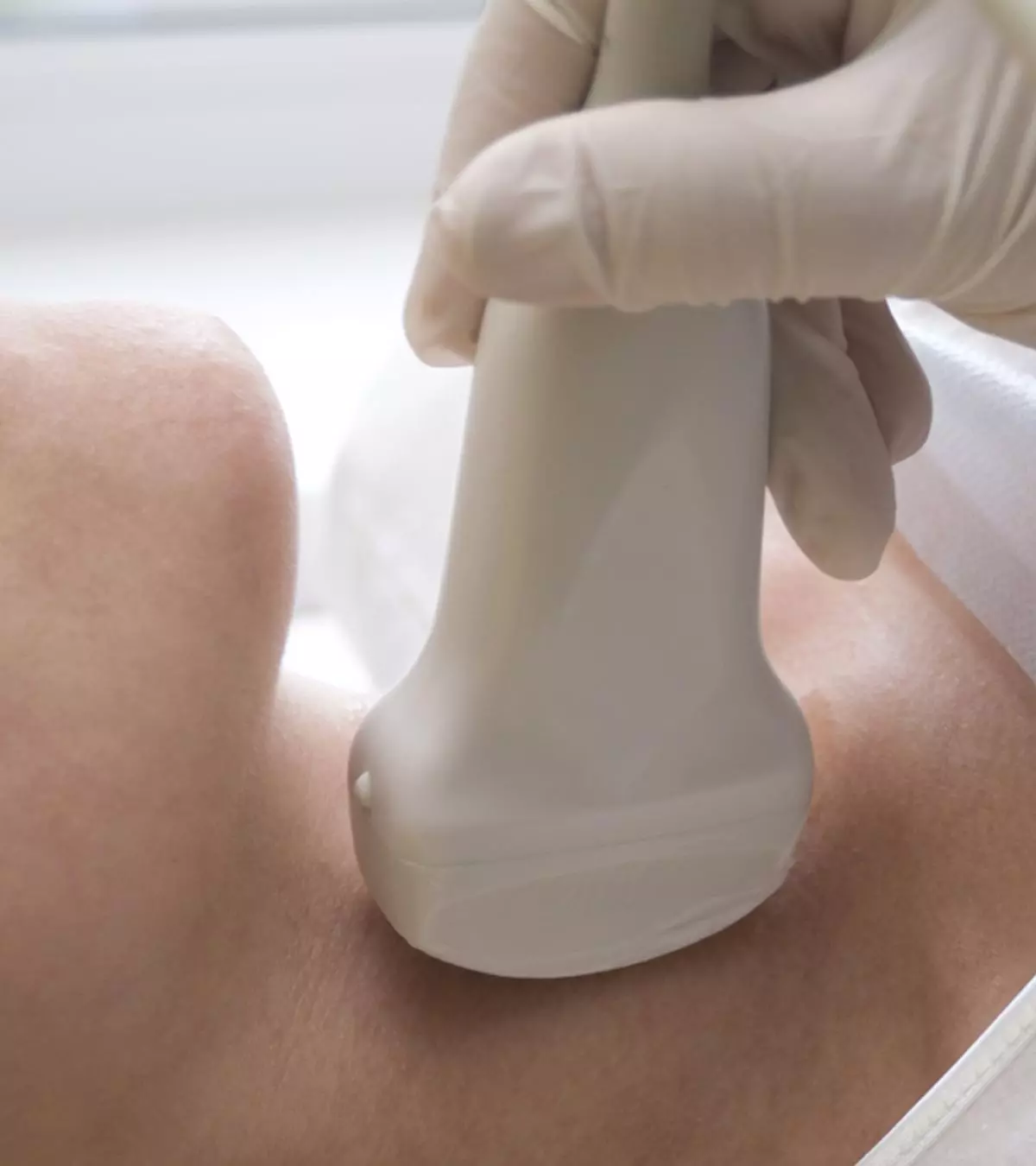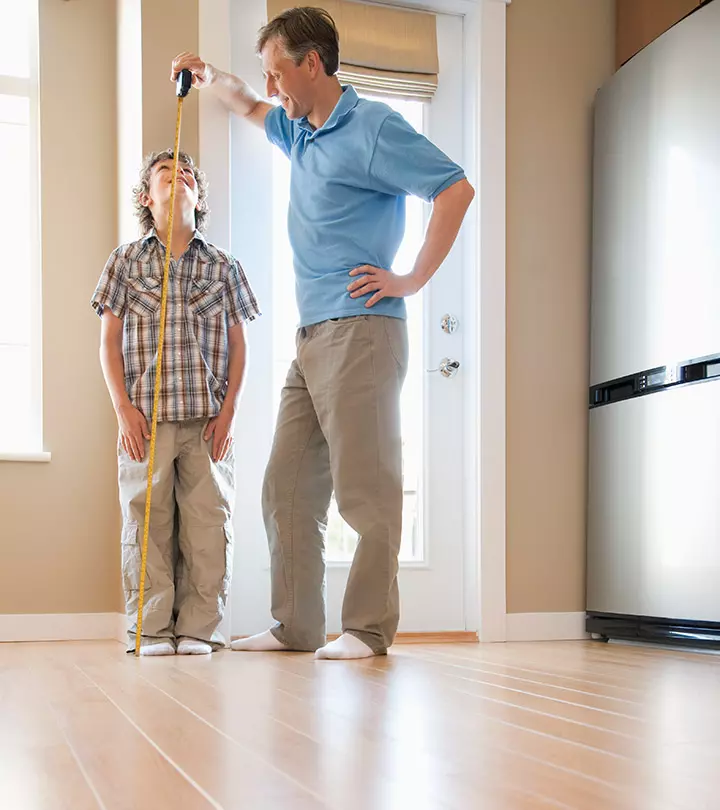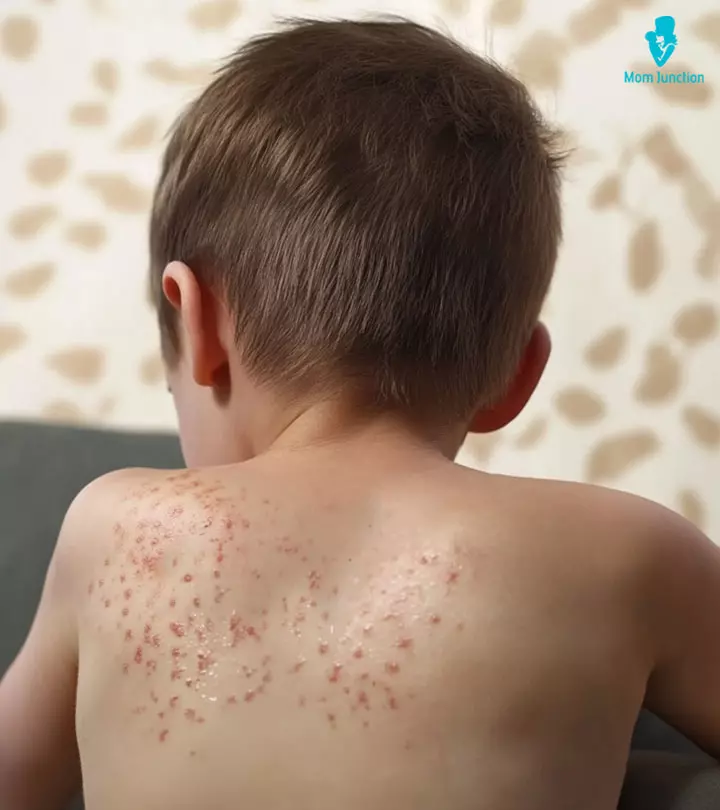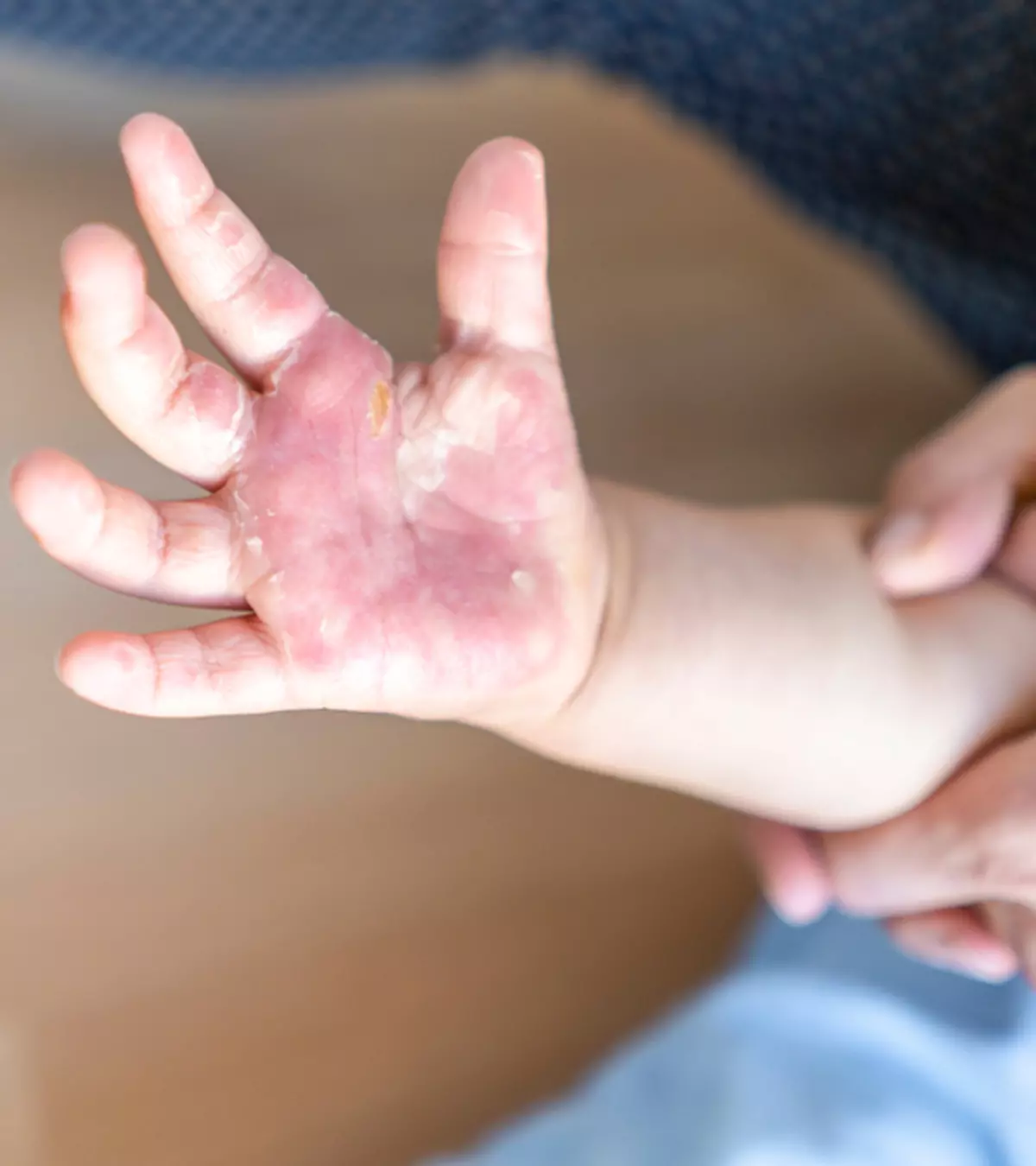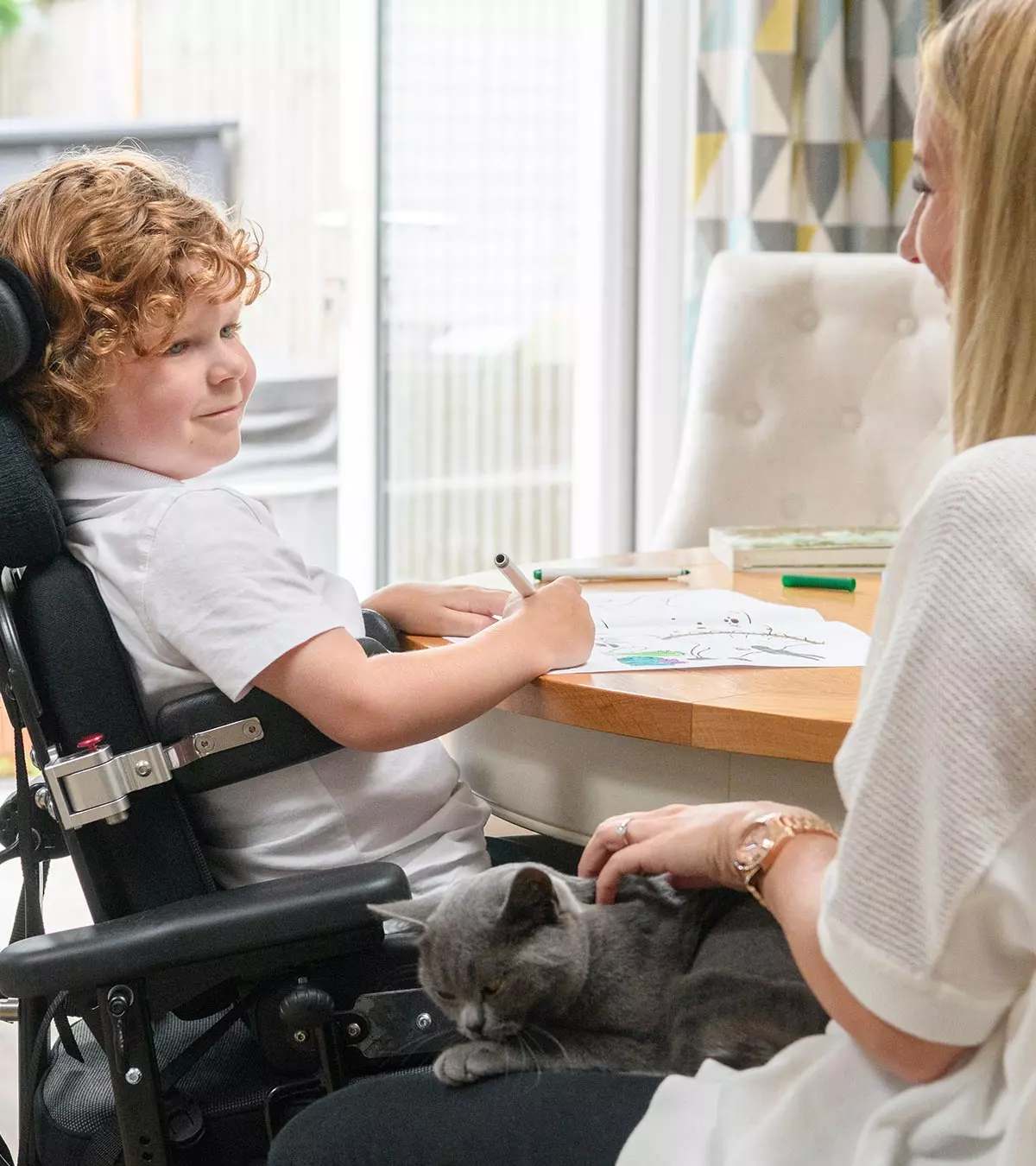
Image: Shutterstock

Dwarfism in children refers to having stunted growth or short stature, i.e. when a child fails to attain the adult height of more than four feet ten inches (1). Dwarfism is usually not considered a disease or an intellectual disability but might lead to certain medical complications. However, you can help your child manage the condition with proper medical attention and care. Children with dwarfism have a normal life expectancy and the usual intellect and abilities to have a regular quality of life (2). The frequency of having a child with dwarfism is one per 25,000 births, and 80% of children with this condition have parents and siblings of average height. Similarly, parents with dwarfism may have children unaffected by this condition (1) (3).
Keep reading to learn about the types, causes, risk factors, complications, diagnosis, and treatment for dwarfism in children.
Key Pointers
- Proportionate dwarfism is characterized by arms, legs, and trunks being shorter than normal and results from growth hormone deficiency.
- Disproportionate dwarfism is characterized by arms and legs shorter than the trunk.
- Dwarfism may occur due to genes, hormonal issues, systemic disorders, and nutritional causes.
Types And Symptoms Of Dwarfism
Dwarfism can be broadly divided into two types based on the child’s physical appearance (1) (4).
- Proportionate dwarfism: In this condition, the child’s overall growth is stunted, and the arms, legs, and trunks are all proportionately shorter than normal. Proportionate dwarfism is usually caused due to growth hormone deficiency. Children with this condition have an overall restricted growth, which may go unnoticed until late childhood or puberty.
- Disproportionate dwarfism: This is a condition characterized by arms and legs that are particularly shorter compared to the trunk.
The most common cause of disproportionate dwarfism is achondroplasia, a genetic disorder that manifests the following features (5) (6).
- Shorter arms and legs compared to the head and trunk
- Large head with flattened nasal bridge and prominent forehead
- Crowded teeth due to the small upper jaw
- Some joints with reduced mobility, and others with higher flexibility
- Short, wide hands and feet with short fingers and toes
- Bowed legs
- Curved spine
Risk Factors And Causes Of Dwarfism In Children
Dwarfism may occur due to genetic conditions, underlying medical conditions, bone diseases, and more (4).
1. Genetic bone disorders

Image: Shutterstock
Dwarfism is commonly caused by genetic bone disorders known as skeletal dysplasias. The faulty bone formations that can cause dwarfism include
- Achondroplasia: It is the most common cause of dwarfism. Achondroplasia has a worldwide birth prevalence of around 4.6 per 100,000, as evidenced by a meta-analysis conducted by multiple institutes. The term means the absence of cartilage, but it involves a failure to convert cartilageiA flexible connective tissue within the body that protects the bones and joints by acting as a shock absorber. to bones, specifically in the long bones of the arms and legs. It is often a result of the fibroblast growth factor receptor-3 (FGFR-3)iA gene that offers protein that regulates cell division, wound healing, growth of bones, and several other functions. gene mutation, which results in defective bone growth in the extremities (4). A similar condition is hypochondroplasia with a similar genetic mutation.
 Quick fact
Quick fact- Pseudoachondroplasia: This condition is similar to achondroplasia but without facial features. It is caused by the mutation of the COMP gene that is crucial for cartilage development and its conversion to bone. The common characteristics of the condition include short arms and legs, a waddling walk, joint pain that progresses to osteoarthritis in adulthood, and flexible joints (7).
- Diastrophic dysplasia: This rare genetic disorder in children affects the sulfate content in the body and causes extensive cartilage abnormalities and bone deformity in the spine, long bones, and feet (8)
- Spondyloepiphyseal dysplasia (SED): SED is a rare genetic disorder that affects the spine, legs, and arms. It interferes with the way collagen protein functions and hampers connective tissue and bone development. SED causes short torso, neck, and limbs, but the hands and feet remain normal. It can also cause the spine to curve (9).
Other genetic disorders that can lead to dwarfism include (4)
- Down’s syndrome
- Turner’s syndrome
- Noonan’s syndrome
- Prader Willi syndrome
- Russell-Silver syndrome
- Short stature homeobox gene deficiency syndrome
- Chondrodysplasias
2. Hormonal disorders
Growth hormones secreted by the pituitary glands are directly or indirectly involved in bone elongation and growth of the cartilage and soft tissues. Any deficiency in these hormones or pituitary gland issues may cause dwarfism.
For instance, gonadotropin hormones released from the anterior pituitaryiOne of the two lobes of the pituitary gland controlled by the hypothalamus. help release sex hormones. Excess or premature release of gonadotropins can cause premature puberty (eight to nine years of age) and maturation of the skeletal system and result in lower adult height (4).
3. Nutritional and systemic disorders
Malnutrition can also lead to slower growth in children. Malnutrition of mothers during pregnancy can also contribute to low birth weight in newborns and stunted growth in children.
The presence of certain chronic diseases such as chronic kidney disease, celiac disease, and inflammatory bowel disease (IBD) can cause defective utilization of nutrients and slow down growth (4).
 Quick fact
Quick factComplications Of Dwarfism
Depending on the cause, dwarfism can cause certain complications during the growth phase of children (1)(6).
- Narrowing of the nasal passages, which may cause breathing difficulties, snoring, and sleep apnea (breathing repeatedly stops and starts during sleep)

Image: Shutterstock
- Ear infections due to the narrowing of the eustachian tube (tube leading from ear to throat)
- Hydrocephalus or head enlargement due to the accumulation of cerebrospinal fluid inside the skull
- Reduced muscle tone and strength. Young children may need neck support for a longer duration.
- Delayed development of motor skills
- Spinal stenosis, where the opening of the vertebral column is so small that it cannot accommodate the spinal cord. It causes pain and numbness.
- Increased lumbar lordosis, which refers to a backward curve in the lower spine.
Diagnosis Of Dwarfism
Dwarfism may be diagnosed before birth at about 20 weeks of pregnancy, soon after, or when the symptoms become evident as the child grows (10).
Dwarfism is diagnosed during pregnancy using
- Routine antenatal ultrasound imaging to identify features such as short limbs and a larger head. Yvette, a mother, shares how her ultrasound imaging and BPP test went. She says, “My fabulous Dr did 3x weekly BPP just to keep tabs on everything. On Aug 2 he also did an ultrasound. The wonderful US tech said that his limbs were showing 6 weeks short and his head was 2 weeks oversized. As a nurse, I knew that those were signs of dwarfism. Due to the decreasing BPP, they decided to deliver him that day. I had 5 hours to deal with the news before he was born. I was crying and distraught to say the least (i).”
- Amniocentesis, which involves withdrawing a small sample of amniotic fluid from the womb to perform laboratory tests for genetic mutations, such as FGFR3 mutations, and diagnose achondroplasia.
- Chorionic villus sampling, which entails removing a tiny part of the placenta via the vagina and cervix to run tests for genetic mutations.
Diagnosis after birth includes (2) (10)
- Physical examinations to check for signs that may not be detectable via a prenatal ultrasound, such as short limbs and a small chest.
- Growth hormone stimulation tests to identify growth hormone deficiencies.
- Brain scans to look at pituitary development.
- CT scans and X-rays to detect bone deformities.
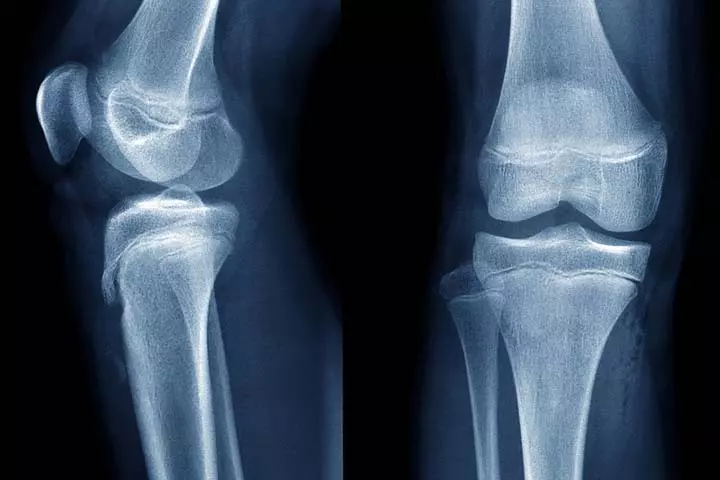
Image: IStock
- MRI to visualize the spinal cord.
- Blood tests to check for genetic anomalies.
- Neurological examination.
- Sleep study to access sleep apnea and other sleeping disorders.
- Ear examination if repeated ear infections are present.
Treatment For Dwarfism In Children
There is no specific treatment for dwarfism. Hence, the treatment options may be aimed at treating the symptoms of conditions that may accompany dwarfism and improving the child’s quality of life.
Treatment with growth hormones may help with dwarfism caused by metabolic and hormonal malfunctions. The National Institute of Health and Care Excellence (NICE) recommends using somatotropin, a recombinant human growth hormone, as an option for treating children with dwarfism associated with the following conditions (11).
- Growth hormone deficiency
- Turner syndrome
- Prader-Willi syndrome
- Chronic kidney disease
- Children who are born small and have not shown adequate growth up to four years of age
- Short stature homeobox‑containing gene (SHOX) deficiency syndrome
NICE instructs that only pediatric endocrinologists, child specialists with expertise in growth hormone-related disorders, should start and monitor any therapy with somatotropin.
The drug Vosoritide has been approved by the European Medicines Agency in 2025 to treat achondroplasia. The drug acts by controlling the activity of the defective FGFR3 gene and is recommended for children aged two years and above whose epiphyses, the growth plates of bones, are yet to close (12).
Skeletal dwarfism cannot be completely reversed. Therefore, supportive care and surgeries are advised for the correction of bone deformities. The doctor may recommend the following treatment options.

Image: Shutterstock
- Extended limb lengthening: The surgery is mainly done for cosmetic and adaptive purposes for increasing the length of the legs and is not a remedy for any clinical symptom. However, it may solve some bone and nerve problems. It is not always recommended as it is a lengthy procedure and may have side effects such as pain, poor bone formation, fracture, and infections (13).
- Corrective surgeries or bracing (supportive devices) for relieving pressure on the spinal cord (for spinal stenosis), spine straightening (for scoliosis and kyphosis), and correcting knee and foot anomalies and hip disorders (14) (15).
- Dental and orthodontic corrections to ensure oral health (6)
Other support therapies to help children with dwarfism include
- Physiotherapy to improve movement and fine motor skills
- Speech therapy and feeding therapy to help with cleft palate
- Support with hearing aids.
Parental Help For A Child With Dwarfism
Dwarfism may lead to issues with social acceptance along with physical hindrances. A parent should learn about the clinical conditions that accompany dwarfism and provide emotional support to their children during their formative years. The way parents represent their child in front of others goes a long way in shaping the child’s personality.
Most children with dwarfism can get good guidance by joining support groups that organize meetings and conferences to address dwarfism-related issues. In addition, parents can help their children with dwarfism progress through their growing years in several ways (16).
- Making periodic visits to the pediatrician or genetic counselor to understand the child’s requirements as their growth timelines are different and unique
- Not experimenting with physiotherapy without proper guidance from medical experts.
- Making appropriate changes that provide neck and back support to the growing child while sleeping
- Checking for age-appropriate behavior such as potty training at the right age
- Keeping a watch on weight gain. The upper part of the body is usually heavier, so maintaining a healthy body weight is important to reduce discomfort and excess pressure on the bones.
- Altering house items, such as adding switch extenders, doorknob extenders, and potty chairs
- Adding adaptive furniture such as stools, tables, and chairs specially made to assist the child do their work independently

Image: Shutterstock
- Making construction changes in the child’s room for easy access to the bed or items on the shelves.
- Choosing appropriate clothing as the child grows.
- Providing opportunities for the child to associate with more people so that they have both short-stature and average-height friends.
- Not reacting to negative comments from others and highlighting the specialties of the child to boost their confidence.
Dwarfism in children is not a disease or disability but a condition that can lead to other complications. This condition can have several causes and lead to complications such as ear infections, reduced muscle tone and strength, and developmental delays in children. Dwarfism can be diagnosed during pregnancy and also after birth. This condition can be treated using growth hormones, corrective surgeries, and dental and orthodontic corrections. With emotional and moral support, parents can create a nurturing environment that helps children feel confident and lead a healthy life.
Frequently Asked Questions
1. At what age is dwarfism apparent?
Sometimes, doctors can diagnose dwarfism during pregnancy when the fetus has shorter arms and legs and a large head in the ultrasound. However, most cases of dwarfism become apparent after a few months or years of birth when doctors notice slow growth in children (17).
2. Is there a vaccine for dwarfism in children?
Recently, the US Food and Drug Administration (FDA) approved Voxzogo (vosoritide) injection to treat dwarfism in children aged five and above. Researchers tested the medicine on 121 participants and found that those who received Voxzogo grew 1.57cm taller than those who received the placebo (18).
3. Can children with dwarfism participate in athletic activities?
Yes. According to the Dwarf Athletic Association of America, people with dwarfism can participate in sports (19).
Infographic: Supporting The Emotional Growth Of Children With Dwarfism
Besides medical care, a child with dwarfism needs support to thrive confidently among the stereotypes. Although people are gradually becoming more aware, these practical tips will help your child enjoy life with healthy social and emotional growth and motivate them not to let their condition obstruct their dreams.
Some thing wrong with infographic shortcode. please verify shortcode syntax
Dwarfism is a growth disorder caused by genetic or medical conditions that may vary in onset and treatability. Learn more about the causes and treatments in this educational animation video.
Personal Experience: Source
MomJunction articles include first-hand experiences to provide you with better insights through real-life narratives. Here are the sources of personal accounts referenced in this article.
i. Our journey with dwarfism.https://bringinghomeholland.blogspot.com/2011/01/our-journey-with-dwarfism.html
References
- Frequently Asked Questions.
https://www.lpaonline.org/faq-#Definition. - Dwarfism.
https://www.hopkinsmedicine.org/all-childrens-hospital/patient-families - Types of Dwarfism.
https://littlepeopleuk.org/information-about-dwarfism-conditions/types-of-dwarfism - Megha Jain and Ahmed Y. Saber; (2025); Dwarfism.
https://www.ncbi.nlm.nih.gov/books/NBK563282/ - Symptoms Restricted Growth (Dwarfism).
https://www.nhs.uk/conditions/restricted-growth/symptoms///. - Dwarfism.
https://www.betterhealth.vic.gov.au/health/conditionsandtreatments/dwarfism#symptoms-of-dwarfism. - Pseudochondroplasia.
https://medlineplus.gov/genetics/condition/pseudoachondroplasia/ - Diastrophic Dysplasia.
https://www.hopkinsmedicine.org/health/conditions-and-diseases/diastrophic-dysplasia - Spondyloepiphyseal dysplasia congenita.
https://medlineplus.gov/genetics/condition/spondyloepiphyseal-dysplasia-congenita/#causes - Diagnosing Achondroplasia in Children.
https://nyulangone.org/conditions/achondroplasia-in-children/diagnosis - Human growth hormone (somatropin) for the treatment of growth failure in children.
https://www.nice.org.uk/guidance/ta188/chapter/1-Recommendations - New treatment for people with dwarfism.
https://www.ema.europa.eu/en/news/new-treatment-people-dwarfism - Extended Limb Lengthening. Little People of America Medical Advisory Board.
https://www.lpaonline.org/index.php?option=com_content&view=article&id=72. - Dwarfism and Skeletal Dysplasias.
https://www.seattlechildrens.org/conditions/dwarfism/. - Spondyloepiphyseal Dysplasia Congenita.
https://www.hopkinsmedicine.org/health/conditions-and-diseases/spondyloepiphyseal-dysplasia-congenita#:~:text=Spondyloepiphyseal%20dysplasia%20congenita%20is%20a%20rare%20genetic%20disorder%20that%20involves,many%20parts%20of%20the%20body. - It’s a Whole New View
https://www.lpaonline.org/assets/documents/LPA%20New%20View%20FINAL.%20122806.pdf - Dwarfism
https://kidshealth.org/en/parents/dwarfism.html - FDA Approves First Drug to Improve Growth in Children with Most Common Form of Dwarfism.
https://www.fda.gov/news-events/press-announcements/fda-approves-first-drug-improve-growth-children-most-common-form-dwarfism - Yes, you can participate!
http://www.daaa.org/participate.html - Achondroplasia in Children.
https://www.cedars-sinai.org/health-library/diseases-and-conditions—pediatrics/a/achondroplasia-in-children.html - Dwarfism (Skeletal Dysplasia) and Other Causes of Short Stature
https://my.clevelandclinic.org/health/diseases/17862-skeletal-dysplasia-dwarfism-and-other-causes-of-short-stature
Community Experiences
Join the conversation and become a part of our nurturing community! Share your stories, experiences, and insights to connect with fellow parents.
Read full bio of Dr. Arva M Bhavnagarwala
Read full bio of Dr. Joyani Das
Read full bio of Dr. Ritika Shah
Read full bio of Vidya Tadapatri







